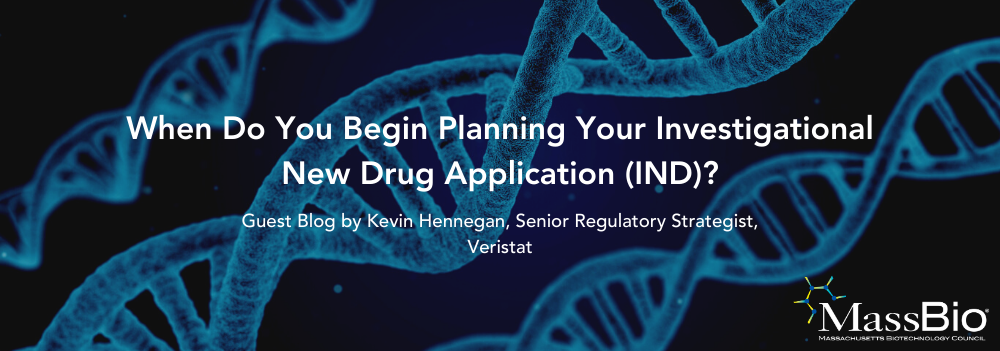
“Many sponsors fail to take full advantage of the support the Food and Drug Administration (FDA) can provide in early drug development, thinking that they need more data than is actually required. When your proof-of-concept data, clinical strategy, and funding begin lining up, it’s time to get serious about your regulatory strategy.”
-Kevin Hennegan, Senior Regulatory Strategist, Veristat
When sponsors are in the pre-clinical stage of development, when should they start thinking about and planning for IND activities?
Many factors play a role, but it ultimately depends on when they want to start conducting clinical trials in the US. That is the purpose of an IND. However, many sponsors begin their clinical programs outside the US, so they may not need an IND immediately. It is also possible, though uncommon, to file a New Drug Application (NDA) using only data collected outside the US, bypassing the need for an IND entirely. Even if all of a sponsor’s studies will take place abroad, opening an IND dossier would allow them to take advantage of the FDA’s drug development program and support.
If we assume part of the clinical program will be conducted in the US, the next piece to consider is the scientific strength of the development program. If the proof-of-concept data is convincing to scientists outside the organization, it is likely to be convincing to the FDA as well. That includes considerations such as replication of results, being able to show the molecule or product’s activity, and a reasonable hypothesis for how the product might treat, cure, prevent, or diagnose human disease. It is not necessary to establish a potential mechanism of action before filing an IND, but they need some of the core scientific data to support their initial filing.
At which point do you have enough data to support an IND?
It varies by product class and indication, as well as the clinical development plan, but a few key pieces should be in place:
- Proof-of-concept scientific data
- A target clinical indication so that the FDA can apply the appropriate context to the application
- A clinical research plan or clinical study profile
- Good Laboratory Practice (GLP)-compliant animal toxicology data, usually in two species, that supports the dose, dosing schedule, administration, and study duration proposed in the clinical protocol. There are many exceptions and nuances to this element, but the central principle is that there must be evidence of the product having a reasonable risk/benefit profile before human trials start.
- Evidence that the sponsor can manufacture the product in accordance with good manufacturing practices (GMP). The amount of data depends on the stage of the program when the IND is filed, but assuming the sponsor is filing the IND to support the first human trial, they need to be able to describe the manufacturing process, have analytical tests confirming the quality of the product, and test results for several batches of the product including at least one GMP-compliant batch.
- Data demonstrating the stability of the drug, under defined storage conditions, or the period of use for the clinical trial. This can be updated later if required.
Do sponsors skip some steps? Are any steps problematic or difficult?
The element that tends to be lagging is stability data. It is often the last piece that is added before submission and sometimes sponsors new in the industry do not realize they can use a leading batch of their product and submit updates in a rolling fashion.
Also, while most sponsors understand GLP toxicology studies need to part of their IND, it can be difficult for them to determine exactly what they need. There are many nuances, and it may not be required or even possible to run them in full compliance with GLP. Obtaining FDA input on a proposed approach through a pre-IND meeting is often very valuable for these studies.
In general, sponsors should go through the list of required information for an IND that is codified in US regulations and make use of the large collection of guidance documents the FDA has published. That said, there is no substitute for experience. Bringing in someone who has gone through several INDs to review the data package and provide a gap analysis can be extremely helpful. That could be a full-time hire or a third-party consultant with regulatory expertise. The FDA can also provide support, informally or through various pre-IND programs.
Should you plan a pre-IND meeting with the FDA?
Yes! I encourage the sponsors I work with to view the FDA as a valuable development partner. In my experience, they have been very interested in engaging with sponsors to encourage the development of new drugs in a safe, effective, and efficient manner. FDA reviewers have a tremendous amount of experience, and while engaging the Agency effectively takes some skill, it is well worth the investment.
About The Author

Kevin Hennegan
Senior Regulatory Strategist, Veristat
Kevin Hennegan has provided strategic clinical and regulatory guidance to the pharmaceutical, biotech and medical device industry for over 15 years. He has led and participated in the preparation of many successful FDA filings, including Investigational New Drug Applications (INDs), New Drug Applications (NDAs), Biologics License Applications (BLAs), Breakthrough Therapy Designations, Orphan Drug Designations, and Fast Track Applications. His experience covers a wide array of therapeutic indications (oncology, neurology, rheumatology, infectious disease, etc.) and product classes (therapeutic proteins, small molecule drugs, cell therapies, gene therapies, vaccines, and more). He is an advocate for patient-focused drug development and excels in engaging the FDA and other regulatory authorities as development partners. Kevin earned a Bachelor’s degree in Microbiology from Colorado State University, and a Master’s degree in Molecular, Cellular and Developmental Biology from the University of Colorado at Boulder.